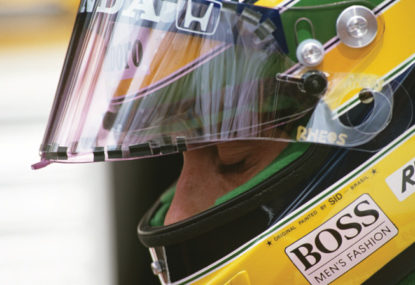Miami Grand Prix talking points: Norris finally breaks the F1 maiden for a fan favourite 2024 victory
The third ever Miami Grand Prix is in the history books and finally Lando Norris has tasted the victory champagne. That is one of…

It’s the catch 22 of success in Formula One. Exploit the rules handed to you too well — that is, do too good a job — and you become the outcast, an undesirable.
Worse than your rival teams complaining about you and seeking to have the x-factor of your performance outlawed, whether it be by banning double diffusers or introducing short cut parity engines, is that fans, too, turn on you for depriving their beloved sport of action and contest.
After two years of mercilessly bludgeoning the competition into submission with only the faintest glimmer of hope, saddled upon its prancing horse in the distance, Formula One sought refuge in its past, nourished by the warmth of its golden years.
That famous era, encompassing almost all of the sport’s history that isn’t right now but particularly the 1980s, when everything was great and there were no problems at all, sheltered the sport from confronting its problems. With rose-tinted glasses immovably affixed to Formula One’s collective face, the answers to its various ailments appeared so effortlessly simple.
If we could do it back then, why can’t we do it now?
But don’t believe the hype — Formula One has never been more competitive.
In this midst of Mercedes mania, making the sport particularly susceptible to this backwards-looking disease, how many times have we been told the sport is looking at ‘returning’ to edge-of-your seat action, often of the sort we fondly remember from Ayrton Senna’s golden era?
“I would say that if you go back and watch the races of the past, when Senna was racing, I think it was less competitive than it is now,” Felipe Massa told me earlier this year. “Even if now it looks very uncompetitive, in that time it was worse!
“People like to go back to the past and say, ‘Ah, because at that time they were amazing, they were fighting’ — they were fighting less than they are now. I don’t think it was really better in the past.”
A short statistical analysis by Motorsport.com proves the point. The average qualifying margin held by the all-conquering 1992 Williams team was almost double the margin Mercedes held this season. Undoubtedly the Mercedes W06 has been untouchable, but the field has become more competitive, not less, over time.
Furthermore, central to Mercedes’ dominance has been its unbeatable power unit, but unfortunately for the sport is that its invention coincided with Formula One’s all-new power unit formula in 2014.
Though indescribably more efficient than engines of old thanks to the use of technology from this century, and being noted by both Renault and Honda as the reason both have recently become involved in the sport after years of the former half-participating and the latter being absent altogether, they still come in for flack because they are ‘too quiet’.
I can understand this — it is difficult to find the words to fully describe the way the scream of the old V10 could rock you to your core, such was their violence — but to pin the sport’s flagging following to Formula One’s noise being less impressive than days of old is absurd.
It is an insult to most of those viewers falling off the wagon to accuse them of understanding Formula One exclusively through the prism of loud noises, and doubly so when the vast majority of them watch on television and to whom therefore the sound makes precisely zero difference.
Had the racing been close and tense between teams and drivers from the get-go, the sport’s pet peeve would be little more than a footnote in whatever thrilling title battle went down to the wire. As we are so bereft of ideas to improve the show, the low-hanging but deeply deceptive fruit that is the noise has been used as a scapegoat when Formula One should rightly be singing the praises of its work on the cutting edge of road car technology.
Is Formula One afraid of the future? Perhaps. Dismissal of McLaren’s MP4-X concept car as nothing more than an experiment is telling considering the technology for the hybrid-power and adaptive chassis closed-cockpit car are all within reach, cost notwithstanding.
But firmer evidence was demonstrated during the 2014 off-season and the impending arrival of teenager Max Verstappen, which prompted the FIA to ban any future driver under the age of 18 from competing in Formula One. This was regardless of his youth being indicative of a global trend of younger athletes given sport’s increasing professionalism.
No matter — just 12 months after the FIA ratified its new minimum age it awarded Verstappen three trophies at its 2015 prize-giving gala — rookie of the year, overtake of the year, and personality of the year.
Worrying less about the past and embracing change is the only way for Formula One, a sport for so long proud of its ability to push the boundaries, to thrive — and obvious conclusion to anyone uninhibited by the rosiness of the past.
Follow @MichaelLamonato on Twitter